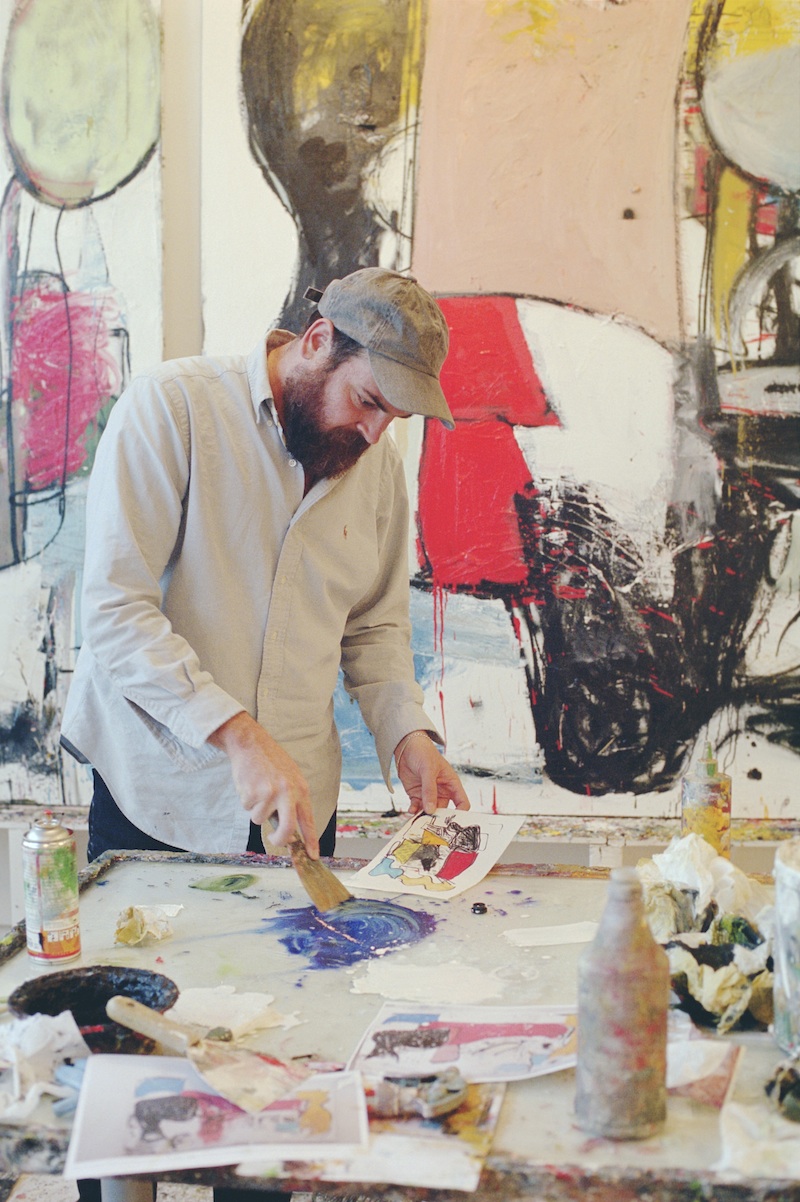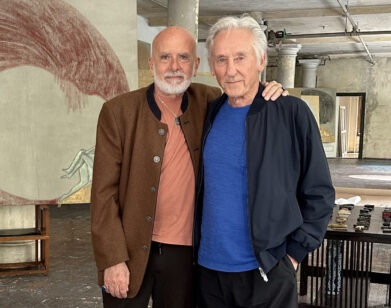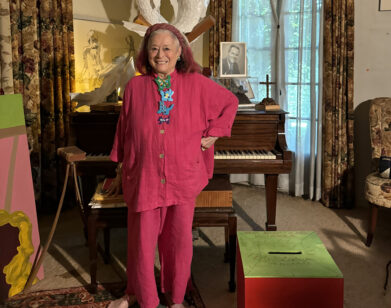Barry McGee x Eddie Martinez
“It’s not hard to like Eddie,” says artist Barry McGee, of fellow artist Eddie Martinez. “Everything was already great.” McGee first met Martinez when the latter was an art handler working to install McGee’s show at a Boston gallery. Martinez was a bit starstruck: “It completely blew our minds because it was obvious that Barry was in town… then he had that show and just really kind of rocked our worlds for a while,” remembers Martinez of himself and his art-school friends. “We went to it all the time. I took my mom to it.”
Almost a decade later, Martinez’s rise to fame might incur similar awe in art-school students. He is known for his colorful and messy canvases, often blending splatters of oil paint with slashes of marker to create figures and shapes rarely situated in any tangible scenery. His first solo show in Los Angeles opens this week at Kohn Gallery, and the new works continue his style of visual blitzes: Viewers might not know where to look, but they won’t be able to look away.
Martinez grew up in Connecticut and briefly studied in Boston before he moved to Brooklyn, New York, without earning his degree. He was included in a number of group shows primarily in New York and Boston before getting his first New York solo show at ZieherSmith Gallery in 2006. Influential art-world voices like Roberta Smith, Jerry Saltz, and Andrew Russeth began to take notice.
McGee and Martinez connected over the phone last Sunday, and it was McGee’s turn to feel a touch starstruck.
EDDIE MARTINEZ: Hey, Barry.
BARRY MCGEE: I’m nervous.
MARTINEZ: So get ready. How was Brazil?
MCGEE: Brazil went well.
MARTINEZ: Good. What were you doing there?
MCGEE: I’m supposed to be interviewing you.
MARTINEZ: Okay, I’ll stop.
MCGEE: I’ll tell you really quick, though. I was there, I was staying in this hospital, this turn-of-the-century hospital, and they were going to tear it down after the show was over.
MARTINEZ: Oh, wild.
MCGEE: Where were you at? Are you anywhere? Are you in Boston?
MARTINEZ: I just got to L.A. a couple hours ago.
MCGEE: Oh okay. Good. Are you excited? Are you ready?
MARTINEZ: Yeah! All that stuff. It’s been shipped out here for a while.
MCGEE: Do you have to be involved with hanging it or anything?
MARTINEZ: Yeah, of course. I’m going to go down there tomorrow morning.
MCGEE: Where are they keeping you at? Are they keeping you at the beach?
MARTINEZ: [laughs] Yeah, I think it’s only underwater. It should be fine with the oil paint.
MCGEE: [laughs] What are you presenting with this new body of work?
MARTINEZ: Paintings and sculptures. I don’t know if you’ve seen any of the sculptures I’ve been working on at all, but just sort of found-objects stuff. I had a painting meltdown last year, so I went out to Long Island and started collecting things off the beach—pieces of buoy and some shit like that—and packing it together. And then I ended up making some large-scale stuff. I guess I started the large scale because I knew it was going to do a show in this large space and I wanted to see if I could do it. So paintings and sculptures and a wall of drawings.
MCGEE: Did you say that you had a painting meltdown?
MARTINEZ: I did, yeah. [laughs]
MCGEE: What exactly does that consist of for you, when you have a painting meltdown? I know what it consists of for me.
MARTINEZ: I never had one, really. Usually after a deadline I’ll take a week off, and then I’ll want to get back to work. I took a few weeks off and then I wanted to go back to work and I just didn’t, and then I couldn’t, and then it was like two months. And then I started to get kind of depressed. I didn’t paint for like six months.
MCGEE: Oh wow.
MARTINEZ: I just made the sculptures and luckily it started working it so I just focused on that. And assumed that painting would happen again.
MCGEE: Drawings, paintings, and sculptures. That’s the three pillars of art academia.
MARTINEZ: [laughs] It’s like hip-hop. It’s like the three pillars of hip-hop.
MCGEE: You’re challenging an entire art history with that right there. It is, don’t you think? 2014, taking on the three things is like…
MARTINEZ: I know what you mean. I haven’t really known how to do anything that I start to do, besides drawing. I didn’t really know how to make oil paintings, and I didn’t know how to make sculptures. I guess I just looked at history for it and tried to figure out how I was going to do it. But that’s kind of how everything has really been for me. Not knowing how to do it and then just figuring out how I do it, and it’s most likely wrong.
MCGEE: It’s looking very good to me.
MARTINEZ: Oh, thank you. [laughs] For instance, I read this thing about Picasso at one point kind of happening upon this ceramic studio that these people were running and he had no idea how to do it. And they said, “Do you want to make some work?” “Yeah, sure, I’ll do it, but I’m just going to do it how I’m going to do it. So if it’s wrong you can’t criticize me for it.” And obviously he made a massive outlet of amazing ceramics.
MCGEE: Yeah, he did. Have you seen that book on plates that he did? All of it is entirely plates. I think he just said he was figuring out his own ways of doing reliefs and everything. Like inverted clay things on plates. I just saw it recently; that’s why it comes to mind.
MARTINEZ: I guess I’m doing the same thing with tennis too [laughs]. I started pretty late in life, like four years ago. Everyone I play with grew up playing, so I kind of scrap it together.
MCGEE: Are you a carbon-fiber racquet or a wood racquet?
MARTINEZ: No, I don’t have a wood racquet. I don’t know what it is. Probably graphite.
MCGEE: But not carbon fiber?
MARTINEZ: Maybe! I actually don’t know.
MCGEE: Is it light?
MARTINEZ: No, I prefer it a bit heavier.
MCGEE: Okay. That tells me a lot about you right there.
MARTINEZ: I use the racquet that’s available to the public. It’s the version of Roger Federer’s racket that you can buy. They don’t release their exact racket to the public—for $250, you get some kind of low-grade version of that.
MCGEE: That tells me you’re getting serious about tennis, though.
MARTINEZ: Yeah, I love it. I’m obsessed with it.
MCGEE: Who do you play with? Do you play against the wall?
MARTINEZ: Yeah, when I have to. I prefer to play with other people. Just friends.
MCGEE: Is Jesse Littlefield one of your friends?
MARTINEZ: Yeah, of course.
MCGEE: Does he play tennis?
MARTINEZ: Yeah! He actually played in high school and I just go him back into it. He certainly is starting to get reinvolved.
MCGEE: Rachel, are you still there?
RACHEL SMALL: I’m still here. I’m on mute.
MCGEE: Jesse Littlefield is a friend that we have in common. He’s in Boston also, in New England, and he used to be a really prolific graffiti artist.
MARTINEZ: Yeah. He’s not any longer though. But he was really good.
MCGEE: He was one of the best of that generation. For sure. I was trying to avoid talking about graffiti in this interview. I just didn’t want to talk about it because…
MARTINEZ: I agree.
MCGEE: I didn’t know if you wanted it to contaminate your interview.
MARTINEZ: No, I don’t care about that.
MCGEE: I’m also supposed to ask you what your childhood was like. How about your strong work ethic?
MARTINEZ: My strong worth ethic?
MCGEE: Does that come out of New England?
MARTINEZ: I don’t know. I was all over growing up. I was in California and in Florida and Texas. I think the only reason I’m able to have a strong work ethic is because I like what I’m doing. I never had a strong work ethic when I worked at Kinko’s or Pearl Paint or anything. I was just interested in feeling as much as I could.
MCGEE: At what age did you live in California?
MARTINEZ: I actually lived in San Francisco when I was in fifth grade. I lived right in Union Square. And I went to a school where there was one white girl, and then me and the rest were Chinese and Vietnamese. Did that in 1988. Then I moved to Massachusetts and then I moved to San Diego in 1992 and was there till the junior year of high school and then I moved to Massachusetts and actually that’s when I met Jesse, in like 1994.
MCGEE: Is this your triumphant return to California?
MARTINEZ: [laughs] I don’t know. I like California a lot. I just don’t think I’d want to live here.
MCGEE: You don’t like it enough to live there.
MARTINEZ: I guess I would just have to make a conscious decision that my life was going to be different. I think it would take a long time to shake off the New York impatience. I was just with my friend driving around, and it took 15 minutes to get gas. The guy wasn’t at the register, then the pump didn’t work, then the car failed. It’s just different.
MCGEE: Someone said you have no respect for the materials that you use—you’re not precious about your materials at all. How do you feel about that?
MARTINEZ: That’s true. I don’t care. It’s just materials. You talk to people all the time and they’re like, “Well, that’s a canvas, I don’t want to do something if it’s not going to work out and then I have to get more paint.” And I guess that comes from the practice of drawing all the time, especially tagging and shit, you’re just doing something on paper over and over and over and before you know you’ve gone through the whole sketch book and it was necessary to do. And that’s how I feel about making a painting or anything else. It’s necessary to exhaust the material so it doesn’t get in the way of how I want to make it.
MCGEE: I think this trip to Brazil just reminded me just how much you can do with very simple materials. They just use rollers and black latex paint. Cast out all the color crap, and the time involved. I think they spend seconds, whereas people [here] seem to spend a lot more time on things.
MARTINEZ: Yeah, I’m definitely more attracted to that kind of stuff.
RACHEL SMALL: Eddie, may I ask a question?
MARTINEZ: Yeah.
SMALL: This is your first solo show in Los Angeles. There’s been a lot of talk about artists moving to Los Angeles for the space; what are your feelings on the differences between Los Angeles and New York in terms of the art world?
MARTINEZ: Well, that’s hysterical, because I was just driving out with my buddy and we went to see his new space. And space is like 50 cents a square foot.
SMALL: That is absurd.
MARTINEZ: It’s crazy! When I say I got a good deal on my new one, that’s like $2.50 a square foot.
SMALL: Oh my god.
MARTINEZ: Yeah it’s crazy. That’s one of the things so attractive about here. A lot of New Yorkers are moving out here. You can get by out here a lot easier. Make more work, make larger work, be kind of off the grid a little more. But I think for me, I would get too isolated. I have a hard enough time in New York seeing people and being social. But yeah, it’s amazing, so we’re just driving around, talking about studios, and Sterling Ruby has I guess a block-long studio. He has 100,000 square feet, dude!
MCGEE: He purchased it off, that wasn’t like a rental, it was an outright buy. Vernon, California. That’s where everyone’s going now.
MARTINEZ: Yeah. The return. The post-gold rush. The post-post.
MCGEE: If you wanna go invisible, you go to Vernon, California right now.
MARTINEZ: Yeah, that’s interesting. I definitely think it’s cool the way people are creating their own utopias out here. I guess they always have. But now that L.A. is quote on the map in the art world, which is what all the New Yorkers say, it seems like a really fertile time out here. Does that answer it, Rachel?
SMALL: Yeah, that sounds great. How did you connect with the Kohn Gallery?
MARTINEZ: Through a New Yorker. [laughs] This woman, Kim, who was curating a show out there, because she used to work out here and have a daughter out here. So she turned me onto it. And then they wanted to show my wife but that didn’t work out. So they got me instead. [laughs] Next in line was our dog, I guess.
SMALL: Would you guys want to talk about the content of Eddie’s show, and what he hopes viewers get from it, or what he’s trying to project, if anything?
MARTINEZ: The thing with viewers, I never have a thing I’m trying to put upon anyone. I think that’s the job of the viewer, to figure out what they want to get out of it. Once it leaves, once I’ve made the thing, it’s not really mine anymore.
MCGEE: Is that good or bad? Is that because it’s sold immediately, or?
MARTINEZ: No, not in that context. I mean like in the sense that I like to relinquish control over it. I made it, it’s done, now it’s for people to look at and see what they want to see. Whenever anyone asks me if it’s this or that, I just don’t say anything, because I don’t want to inform it any more than I already did in the studio.
MCGEE: I can respect that.
MARTINEZ: Barry, to go back to the thing about drawing, I think something you might find interesting if you’re able to see the show, is that for me, particularly the large paintings—I made those nine-by-twelve foot paintings—those kind of solidify what I’ve been trying to do for a long time, which is to make a large painting feel like a drawing, like sitting on the couch with a Sharpie, just making a little line drawing. Because at that scale, it’s like the arm movements translate pretty seamlessly into a hand movement. I’m kind of dancing around this thing, doing it as quick as possible, and just letting the marks fall where they fall. And I think it really kind of worked on one of these paintings.
MCGEE: Do you have any assistants helping you right now?
MARTINEZ: Yeah, I had some help with the large sculptures. That’s just impossible to do alone.
MCGEE: Are they ceramics or plaster?
MARTINEZ: They’re plaster and foam and found material and wood. Mostly plaster, I guess.
MCGEE: A little bit of spray paint at the end?
MARTINEZ: Oh yeah. Always. Spray paint still remains as one of the most satisfying tools to use. [laughs] It’s just so fast. And it dries fast.
MCGEE: Some of the spray paints smell pretty good, too.
MARTINEZ: Oh, my god. Yeah I love it. All the new designer stuff smells like fucking candy. And they say the more it smells like candy, the more toxic it is, but that stuff smells like candy is supposed to be this new hybrid acrylic stuff. So I don’t know. But I love huffing it all, it smells good.
MCGEE: Easy Eddie, easy, you have a long life ahead of you.
MARTINEZ: I’m kidding. I know huffing is not smart.
MCGEE: I do it just when I’m low on energy. [laughs] A couple sprays and that’s it.
“EDDIE MARTINEZ: NOMADER” IS ON VIEW AT KOHN GALLERY IN LOS ANGELES THROUGH OCTOBER 25.







